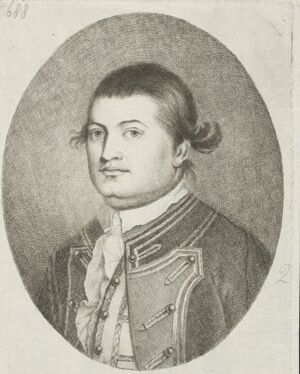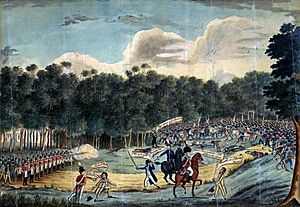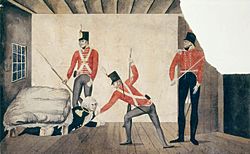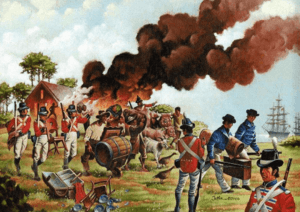New South Wales Corps facts for kids
Quick facts for kids New South Wales Corps |
|
|---|---|
| Active | 1789–1818 |
| Country | |
| Branch | British Army |
| Type | Line infantry |
| Size | One battalion |
| Nickname(s) | "Rum Corps" |
| Facings | Yellow |
| Engagements |
|
| Disbanded | 24 March 1818 (as the 100th Regiment of Foot) |
| Commanders | |
| Notable commanders |
|
The New South Wales Corps was a group of British soldiers. They were formed in 1789 in England. Their job was to take over from the soldiers who came with the First Fleet to the new New South Wales in Australia. In Australia, the New South Wales Corps became famous for trading in rum. They also sometimes caused trouble by not always following orders.
Later, the Corps was renamed the 102d Regiment of Foot. They moved to Bermuda and Nova Scotia. They even fought in the Chesapeake campaign during the War of 1812. After the war, they were renamed again as the 100th Regiment of Foot. The group was finally disbanded in 1818.
Contents
History of the Corps
How the Corps Started
This army group was created in England in June 1789. It was a permanent unit. Its main goal was to replace the New South Wales Marine Corps. Those Marines had come with the First Fleet to Australia.
The first soldiers of the New South Wales Corps arrived in Australia in 1790. They came as guards on the Second Fleet. Major Francis Grose led the regiment. It had three companies, with about 300 men. More soldiers were sent from Britain later. But the group never had more than 500 men in total.
A fourth company was formed from Marines who wanted to stay in New South Wales. Captain George Johnston led this new group. He had been an assistant to Governor Arthur Phillip.
When Governor Phillip went back to England in 1792, Major Grose took charge. Grose quickly changed Phillip's plans for the colony. He was a strong military man. He made sure the Corps had full authority. He got rid of the civilian courts. He put the judges under the control of Captain Joseph Foveaux.
After bad harvests in 1793, Grose cut the food for the convicts. But he did not cut the food for the Corps. This was different from Phillip's rule of equal food for everyone. Grose also gave large land grants to Corps officers. He wanted to improve farming. The officers also got convicts to work on their farms. The government fed and clothed these convicts.
The "Rum Corps" and Trading
Grose also allowed the trading of rum. Governor Phillip had banned this. Rum was a common term for strong alcoholic drinks. It often came from Bengal. The colony, like many British places, did not have many coins. So, rum quickly became a way to trade for things.
Officers in the Corps used their power and money. They bought all the imported rum. Then they exchanged it for goods and work. They made a lot of money this way. This is how the Corps got its nickname, "The Rum Corps." By 1793, equipment for making rum was brought in. Grain was even used to make rum. This made the grain shortage even worse.
Major Grose returned to England in 1794 due to poor health. Captain William Paterson took temporary command. A new governor, John Hunter, arrived in 1795.
Governor Hunter tried to stop the officers from buying rum. He used Corps soldiers to guard imported rum. But his efforts were not successful. Other governments did not help. Corps officers even hired a Danish ship. It brought a large shipment of rum from India. Hunter also tried to open a public store. It would sell goods from England. This was meant to create competition and lower prices. But Hunter was not good at business. Supplies were also very unreliable.
Hunter asked for more control from England. He also wanted a tax on rum. He tried to limit how many convicts officers could use for work. But he could not make them follow this rule. Corps officers strongly opposed Hunter. They spread pamphlets and letters against him. John Macarthur wrote a letter. It accused Hunter of being ineffective and trading rum himself. Hunter had to answer these charges. Soon after, he was called back to England. He was seen as ineffective.
In 1799, Paterson, now a Lieutenant Colonel, returned from England. He had orders to stop the rum trading by officers. In 1800, he accused Major George Johnston. Johnston had paid a sergeant partly in rum at a very high price. Johnston said he was being unfairly treated. He demanded to be sent to England for trial. English courts decided that colonial matters were not their concern. They said any trial should be in Sydney. This was because all the evidence and witnesses were there. They also said a proper court-martial could not happen in Sydney. So, no further action was taken against Johnston.
Governor Philip King arrived in 1800. He continued Hunter's efforts to stop rum trading. King had the power to tax alcohol. Ships now had to pay a bond. This bond was lost if they disobeyed the Governor's orders. These orders included not bringing in more than 500 gallons of rum. King also encouraged private traders. He opened a public brewery in 1804. He set values for Indian copper and Spanish coins. These were used as money. But it was still hard to keep coins in the colony.
King's actions were not completely effective. But they still angered the Corps officers. Like Hunter, King was attacked in pamphlets. King tried, but failed, to court-martial the officers responsible.
The Vinegar Hill Uprising
The Corps was called into action in 1804. They responded to the Vinegar Hill uprising. This revolt was named after a similar event in Ireland. On the night of March 4, 1804, many Irish rebels rose up. They were at the government farm at Castle Hill. They armed themselves with muskets and pikes. They planned to attack Parramatta and take Sydney Town. Some say they wanted to take ships and sail back to Ireland. Others say they wanted to declare a "Republic of New Ireland."
An alarm around 11 PM woke Major Johnston. He led 29 soldiers of the New South Wales Corps. They marched quickly from Annandale to Parramatta. They arrived around dawn. Later that morning, they pursued the rebels. The rebels were heading to Green Hills, now Windsor.
Johnston pretended to meet with the rebels. A priest helped lure them. Johnston took the rebel leaders hostage. The rebels and their men refused to give up. They shouted "death or liberty!" The troops quickly stopped the revolt. For the next three days, punishments were harsh. Governor King praised Major Johnston's actions. But King had to step in. He stopped a military court from hanging one in ten of the rebels. At midnight on March 4, Captain Daniel Woodriff of HMS Calcutta landed 150 of his crew. They helped the New South Wales Corps and Governor King.
The Rum Rebellion
Governor King had asked for a replacement for a year. Finally, Governor William Bligh was appointed in 1805. By 1806, the colony's economy had grown. But Bligh arrived determined to control the Corps. He especially wanted to control John Macarthur. He wanted to stop their rum trading. This led to the Rum Rebellion. Governor Bligh was removed from power. The New South Wales Corps was eventually called back to England.
In 1808, the New South Wales Corps was renamed the 102d Regiment of Foot. Governor Lachlan Macquarie arrived in the colony in December 1809. He came with the 73rd Regiment of Foot. This new regiment was to take over from the 102d Regiment. Macquarie was able to control the rum trade better. He started a licensing system and made sure it was followed.
However, there was still a lack of money. So, Macquarie had to pay for public works with rum. For example, Sydney Hospital was built this way. The builders were given a special right to import rum. These builders were merchants Alexander Riley and Garnham Blaxcell, and surgeon D'Arcy Wentworth. Soldiers were used to stop rum from being landed anywhere else. It could only be landed at the hospital dock.
Some officers and long-serving soldiers from the 102d Regiment joined Macquarie's 73rd regiment. This made the new regiment almost full strength. About 100 older or injured soldiers stayed for guard duty in New South Wales.
Fighting in the War of 1812
Most soldiers of the 102d Regiment of Foot sailed for England in May 1810. When they arrived, many joined other army groups. Most officers joined the 8th Royal Veteran Battalion. The regiment was reformed with new soldiers. This happened after it reached its new base in Horsham in October 1810. It was sent to Guernsey in July 1811.
In 1812, the regiment was sent to the Bermuda Garrison. This was at the start of the War of 1812.
In 1813, Lieutenant-Colonel Sir Thomas Sydney Beckwith arrived in Bermuda. He was to lead a force to attack the Atlantic coast of the United States. This was especially in the Chesapeake Bay area. The 102d Regiment's leader, Lieutenant-Colonel Charles James Napier, was his second-in-command.
Beckwith divided his force into two groups. One group was made of the 102d Regiment. It also included Royal Marines and two companies of French prisoners-of-war. These Frenchmen had joined to help the Bermuda garrison. Napier commanded this group. The other group was led by Lieutenant-Colonel Williams of the Royal Marines.
They sailed on naval ships on June 8, 1813. They took part in the Battle of Craney Island on June 22, 1813.
After raiding the U.S. Atlantic coast, they left the Chesapeake. They landed at Halifax, Nova Scotia, on September 20, 1813. The Royal Marine battalion went to Quebec. Napier was left with 1,000 soldiers and three cannons. There was a plan to move the 102d to operations in the American south. But this did not happen. Napier moved to the 50th Regiment of Foot in September 1813.
Some parts of the 102d Regiment of Foot stayed after the war ended in December 1814. They were on both sides of the border. This was between the British colony of New Brunswick and the U.S. state of Maine. They were at Moose Island, now Eastport, Maine. After three years in New Brunswick, they sailed back to England in late 1817. Major Gustavus Rochford commanded them.
After the wars against France and the United States, the British Army disbanded many units. This was to save money. The regiment was reorganized as the 100th Regiment of Foot in 1816. This regiment was the last British unit to occupy parts of the United States. The last soldiers returned to Chatham in England. The regiment was disbanded there on March 24, 1818.
Leaders of the Corps
Here are the main leaders of the regiment: New South Wales Corps
- Major Francis Grose (1789–1794)
- Lieutenant Colonel William Paterson (1794–1809)
102d Regiment of Foot
- Lieutenant Colonel William Paterson (1809–1810)
- Major George Johnston (1810–1811)
- Lieutenant Colonel Charles James Napier (1811–1813)
- Major Gustavus Rochford (1813–1818)
Officers Who Became Important Colonists
Many officers from the regiment became rich and powerful. They used their positions unfairly while in charge of the colony. These officers and their families became important people in Australia. They became government officials and large landowners. Here are some examples:
- Captain John Macarthur: He helped start the Merino wool industry in Australia. He also founded the Australian Agricultural Company. He owned a lot of land at Camden.
- Captain William Cox: He built the road across the Blue Mountains. He was also an important farmer in the Hawkesbury and Bathurst areas.
- Captain John Piper: He owned a lot of land in Sydney and Bathurst.
- Captain Edward Abbott: He was an important colonist in Tasmania.
- Lieutenant William Lawson: He explored across the Blue Mountains. He was also a major landowner in the Mudgee region.
- Lieutenant Anthony Fenn Kemp: He was an important colonist of Tasmania.
- Lieutenant Archibald Bell Sr.: He was an important landowner in the Hawkesbury region.
- Surgeon John Harris: He owned a lot of property in Sydney and the Bathurst region.
- Lieutenant Nicholas Bayly: He owned a lot of land in the Cabramatta region.
See also
- Colonial forces of Australia
- Rum Rebellion





